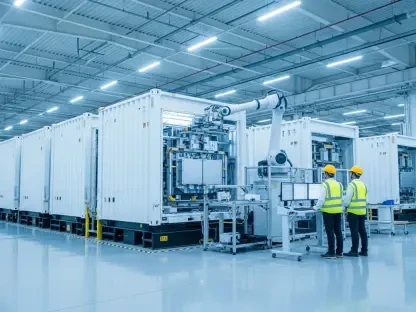Enhanced Geothermal Systems (EGS) are emerging as a promising technology within renewable energy, aiming to contribute to global decarbonization and the transition away from fossil fuels. EGS modifies geothermal energy by drilling into deep hot rock formations, fracturing the rock, and circulating fluids to harness Earth’s heat for power production. Unlike conventional systems relying on natural reservoirs, EGS actively creates its own, significantly expanding the geographical potential for geothermal energy.
Historical and Global Initiatives
Pioneering Efforts in the United States
The journey of Enhanced Geothermal Systems (EGS) began in earnest during the 1970s with the Fenton Hill project in New Mexico. Managed by Los Alamos National Laboratory from 1974 to 1995, this pioneering effort marked an essential milestone in geothermal technology despite facing considerable challenges. The project, which involved drilling wells approximately 3 kilometers deep into Earth’s crust to reach reservoir temperatures near 200°C, aimed to demonstrate the feasibility of creating artificial geothermal reservoirs. Although the Fenton Hill project struggled with maintaining reservoir pressure, managing water losses, and ensuring consistent fluid circulation, these challenges provided invaluable lessons that laid the groundwork for future EGS developments worldwide.
The foundational knowledge gained from Fenton Hill has spurred continued interest and exploration in EGS within the U.S. The experience highlighted the necessity for advanced drilling techniques and robust reservoir management strategies, which have since become integral components of modern EGS projects. The pioneering work at Fenton Hill underscored the potential of EGS to break free from traditional geothermal energy constraints, setting the stage for subsequent technological advancements and collaborations that continue to shape the field.
European Contributions
Europe’s notable contribution to the evolution of EGS is exemplified by France’s Soultz-sous-Forêts project, which has been operational since the mid-1980s. This long-running project involved drilling multiple wells up to 5 kilometers deep into the Earth’s crust, aiming to create and sustain a geothermal reservoir capable of generating electricity. By 2016, Soultz-sous-Forêts successfully achieved a sustained electricity generation capacity of approximately 1.7 MW. The extensive operational history of this project has provided critical insights into reservoir stimulation techniques, operational reliability, and the management of seismic risks, establishing best practices that have become benchmarks for ongoing and future EGS initiatives.
The lessons learned from the Soultz-sous-Forêts project are invaluable. The meticulous documentation of operational parameters, reservoir performance, and the adaptation of advanced monitoring technologies have contributed significantly to understanding the complexities of EGS. These insights have been disseminated widely, encouraging more research and development activities across Europe. The collaborative efforts in the region aim to leverage the Soultz experiences to further innovate and refine EGS, enhancing its reliability and expanding its application across diverse geological settings.
Seismic Risks in EGS Projects
Not all EGS endeavors have met with unblemished success. The significant seismic risks associated with the technology were starkly highlighted by projects such as Basel, Switzerland, and Pohang, South Korea. In 2006, during hydraulic stimulation activities at depths of 5 kilometers, Basel experienced a magnitude 3.4 earthquake, which raised public concern and ultimately led to the project’s termination. This event underscored the potential dangers of induced seismicity due to EGS operations and emphasized the critical need for careful site selection and rigorous seismic risk management protocols.
Similarly, the Pohang project in South Korea, initiated in 2017, triggered a magnitude 5.5 earthquake, causing notable damage to local infrastructure and prompting a halt in EGS developments in the region. These incidents have underscored the imperative of understanding and mitigating seismic risks inherent in EGS activities. Effective risk management strategies, including comprehensive site assessments, continuous seismic monitoring, and cautious hydraulic fracturing practices, are essential in ensuring that the benefits of EGS can be harnessed safely and responsibly.
Technological Innovations
Borrowing Techniques from Oil and Gas
The last decade has witnessed a revival of EGS prospects thanks to significant technological advancements, many of which were adapted from the oil and gas industry. Techniques that revolutionized shale gas extraction are now being repurposed to enhance geothermal energy production. One notable example is Fervo Energy’s “Project Red” in Nevada, representing the forefront of modern EGS development. Founded by former oil and gas engineers, Fervo Energy employs advanced horizontal drilling techniques, multi-zone hydraulic fracturing, and real-time fiber-optic sensing technology borrowed from the shale industry to optimize geothermal energy extraction.
Project Red has garnered substantial backing from prominent investors, including Breakthrough Energy Ventures and Google, highlighting the increasing corporate and venture interest in EGS. The application of horizontal drilling techniques allows for more extensive reservoir access and improved heat extraction efficiency. Paired with sophisticated monitoring technologies, Fervo Energy can precisely manage fluid flow and monitor reservoir performance, ensuring stable and sustained electricity generation. These advancements demonstrate the feasibility of integrating oil and gas extraction techniques into geothermal applications, potentially transforming the EGS landscape.
Breakthroughs in Reservoir Monitoring
Innovations in reservoir monitoring have also been pivotal in advancing EGS technology. Real-time fiber-optic sensing technology, as employed in Fervo Energy’s Project Red, enables continuous monitoring of reservoir conditions and fluid dynamics. This technology provides a more accurate and detailed understanding of reservoir behavior, allowing for immediate adjustments to maintain optimal performance. In Project Red, the successful application of these innovations has resulted in sustained fluid circulation equivalent to approximately 3.5 MW of stable electrical generation. Overcoming hurdles such as managing high temperatures and ensuring consistent flow rates, these technological breakthroughs have set a new standard for EGS operations.
The significance of these advancements extends beyond Project Red. The ability to precisely monitor and adjust reservoir conditions in real-time enhances the overall efficiency and reliability of EGS projects. This level of control reduces the risk of operational failures and maximizes the energy output from geothermal reservoirs. As these monitoring technologies continue to evolve, they hold the potential to further improve the viability of EGS as a major player in the renewable energy sector.
Technical and Economic Challenges
Extreme Drilling Conditions
Despite the promising advancements in EGS technology, the process of deep drilling presents significant technical and economic challenges. EGS projects often require drilling to depths of 4-7 kilometers, where rock temperatures frequently exceed 250-350°C. These extreme conditions pose a considerable challenge to equipment durability, particularly for polycrystalline diamond compact (PDC) bits, which lose their hardness and durability at temperatures above 250°C. The frequent need to replace these critical components significantly increases drilling time and operational costs, prompting ongoing research into more robust alternatives such as thermally stable diamond-impregnated bits and advanced ceramic or composite drill bit materials.
The high temperatures encountered during EGS drilling also adversely impact downhole electronics, which are crucial for directional drilling, monitoring, and reservoir management. Conventional electronic systems quickly fail at temperatures exceeding 175-200°C, necessitating the use of costly protective measures such as active cooling systems or high-temperature-rated electronics and fiber-optic sensors. Current research is focused on developing high-temperature electronics and insulation technologies to extend the lifespan and reliability of these critical systems.
Economic Constraints
The harsh conditions of deep drilling for EGS not only present technical challenges but also create significant economic constraints. Drilling operations at such depths face immense pressures that threaten borehole stability, potentially leading to collapse. Pressure variations can destabilize the borehole, causing expensive delays and the need for additional casing and cementing. Addressing these issues requires advanced borehole stabilization techniques, specialized cement formulations, and casing materials engineered to withstand extreme temperatures and pressures. All of these factors substantially elevate the risks and costs associated with EGS drilling operations.
As a result, drilling typically constitutes over half of the total capital expenditure for EGS projects, leading to relatively high electricity generation costs. Current estimates place these costs between $0.10 and $0.25 per kWh, which is considerably higher than those for solar energy, ranging between $0.03 and $0.06 per kWh. However, there is potential for significant cost reductions with improved drilling efficiencies and access to hotter, deeper resources. For instance, tapping into significantly hotter reservoirs (around 400°C) could reduce the number of wells required for a 100 MW installation, thereby increasing energy extraction efficiency and lowering overall costs.
Financial Implications
Cost Analysis
The financial landscape for EGS projects remains complex and challenging. The high capital and operational costs associated with initial EGS sites, such as Fervo’s project, suggest electricity costs could be in the range of $0.30 to $0.40 per kWh when transmission and distribution are included. These steep costs make broad industrial adoption unlikely, even though tech giants like Google might fund such projects for specific applications, such as data centers. The economics of EGS pose a substantial barrier to its widespread deployment, which is further compounded by the inherent uncertainties and risks involved in the technology.
Moreover, since EGS projects operate under fundamentally different economic constraints compared to shale oil and gas, achieving similar financial viability remains a significant challenge. Shale oil development benefits from economies of scale by drilling multiple horizontal wells from a single pad, whereas EGS wells require significant spacing to prevent thermal interference. This prevents the sharing of infrastructure costs across multiple wells, which is a key advantage in shale oil development. Each EGS well becomes a costly, independent mini-project, raising overall project expenses and complicating the economics of scaling EGS technology.
Long-Tailed Risks in EGS
The financial implications of EGS are further compounded by inherent long-tailed risks and project complexities, as analyzed by Bent Flyvbjerg. Unlike shale oil, which mitigates risks through volume and standardization, EGS faces amplified risks due to site-specific geologies and the bespoke nature of each project. While shale oil projects follow a standard formula, reducing surprises and learning curves, every EGS well encounters unique geological conditions that could lead to project-threatening issues. A failure in an EGS well can jeopardize entire projects, highlighting the high likelihood of catastrophic overruns due to site-specific constraints.
Industrializing EGS and overcoming these long-tailed risks require substantial investments in research, development, and innovation. Standardizing EGS processes and reducing the variability between individual projects are essential to diminishing financial uncertainties and attracting broader investments. However, the complex nature and inherent geological challenges of EGS technology suggest that achieving an industrial-scale rollout will necessitate ongoing advancements and a sustained commitment to innovation.
Environmental and Social Impacts
Seismic Risk Management
While EGS offers the promise of clean and reliable power with minimal emissions and a smaller footprint compared to other energy sources, the significant seismic risks present a substantial challenge. Managing induced seismicity is crucial to gaining public trust and ensuring the safe implementation of EGS projects. Effective mitigation strategies include precise seismic monitoring, adaptive stimulation practices, and comprehensive community engagement to address concerns and build public acceptance. Transparent communication about potential risks, along with proactive measures to mitigate seismic impacts, is essential to fostering support for EGS initiatives.
Innovations in Drilling Technology
The potential for EGS to revolutionize renewable energy is further bolstered by ongoing innovations in drilling technology. Emerging techniques such as plasma drilling and millimeter-wave (MMW) drilling hold promise for making EGS more cost-effective and efficient. Plasma drilling, which utilizes high-energy plasma jets to fracture rock without mechanical contact, could reduce drilling costs and downtime significantly. Similarly, MMW drilling, being researched by Quaise Energy, employs high-powered microwave beams to economically drill beyond 10 kilometers depth at ultra-high temperatures above 400°C. While these technologies are still in their early stages, they represent transformative potentials that could revolutionize the economics of EGS and make it more competitive with other renewable energy sources.
Although these innovative drilling technologies introduce new uncertainties, their successful development and implementation could pave the way for more cost-effective and reliable EGS projects. These advances are crucial for overcoming the significant technical and economic challenges currently hindering the widespread adoption of EGS. By continuing to invest in research and development, the renewable energy sector can unlock the full potential of EGS and guide it toward becoming a major contributor to global energy solutions.
Future Prospects
Scalability and Cost Reduction
To achieve its full potential, EGS must overcome substantial technological and economic hurdles, particularly in the areas of drilling efficiency, seismic risk management, and industrial scaling. While substantial scaling and cost reductions are projected to take at least a decade or two, the ongoing research and innovation within the field of EGS hold promise for future advancements. By improving drilling technologies, reducing operational costs, and enhancing the safety and reliability of EGS projects, the renewable energy sector can foster a more favorable environment for the broader adoption of this promising technology.
EGS in the Renewable Energy Mix
Enhanced Geothermal Systems (EGS) represent a cutting-edge technology within the renewable energy sector, offering substantial promise in the effort to achieve global decarbonization and shift away from dependency on fossil fuels. Traditional geothermal energy systems rely on naturally occurring reservoirs of hot water, but EGS innovates by drilling into deep layers of hot rock. Once the drilling is complete, the rocks are fractured, and fluids are circulated through these fractures to capture Earth’s thermal energy.
This approach to geothermal energy production is distinct because it does not depend on existing geothermal hotspots but instead creates its own reservoirs. Consequently, EGS greatly expands the range of locations where geothermal energy can be generated. By tapping into previously inaccessible geothermal resources, EGS has the potential to make geothermal energy viable in regions where traditional methods would be ineffective.
Moreover, EGS can contribute significantly to reducing greenhouse gas emissions by providing a reliable and sustainable source of clean energy. This innovative technology is gaining attention for its ability to complement other renewable energy sources such as wind and solar, offering a more stable and continuous power supply. As the world looks towards achieving energy sustainability, the role of EGS is likely to become increasingly prominent, providing a new pathway for harnessing geothermal power far beyond the limitations of natural geothermal reserves.









